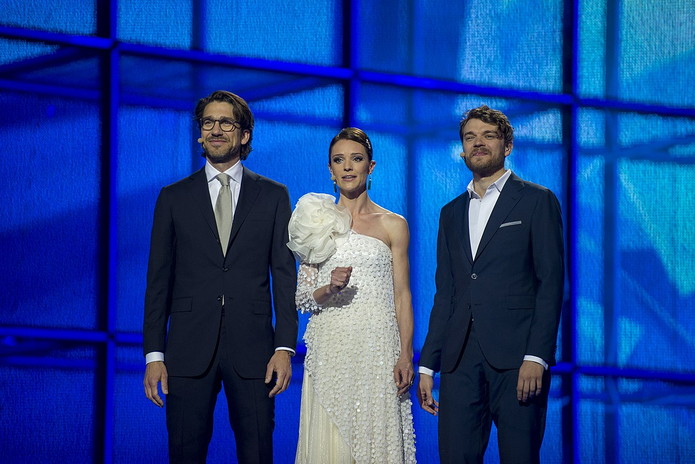 The Eurovision Song Contest typically celebrates political neutrality as much as it does artistic creativity, but few could moan when it was revealed that Ukraine had won the 2022 edition of the event.
The Eurovision Song Contest typically celebrates political neutrality as much as it does artistic creativity, but few could moan when it was revealed that Ukraine had won the 2022 edition of the event.
The singer of their entry, Ivanna Khvalyboga, hailed the victory as bringing ‘incredible happiness for Ukraine and Ukrainian people’, and given what they have been through – and continue to go through – following the Russian invasion, well, you can’t say fairer than that.
Given that Ukraine were always likely to win the 2022 contest, the event became a battle for second place in reality – respect then to Sam Ryder, who ended years of hurt for the UK by finishing as the silver medallist with a strong 466-point showing.
But in truth the ‘Space Man’ singer didn’t really stand a chance of winning given that the Ukrainian entry from Kalush Orchestra amassed 631 points – one of the highest scores in Eurovision history.
It should be said that the points system has been changed so many times that it’s hard to compare what has been the best Eurovision performance of all time, but there’s no doubt that Ukraine have secured their place in the competition’s folklore with their effort in 2022.
How Does the Eurovision Points System Work?

Eurovision uses a positional voting system, with points awarded based upon the rank that an entry is given by the judges.
As of 2016, each competing country gets two sets of points to dish out – one from their chosen judge, and the other from all of the votes accrued from TV viewers in that particular nation. That doubled the number of points available to be won, and confirms why the highest scores in Eurovision history have come since.
The points are allocated as follows:
Eurovision Song Contest Scoring System
| Rank | Points |
|---|---|
| 1st | 12 |
| 2nd | 10 |
| 3rd | 8 |
| 4th | 7 |
| 5th | 6 |
| 6th | 5 |
| 7th | 4 |
| 8th | 3 |
| 9th | 2 |
| 10th | 1 |
Between 1975 and 2015, each country only had one set of points to award – decided almost unilaterally as a 50% weighting from the judges and 50% by the televoting scores.
Between 1957 and 1974, the scoring system changed on a regular basis. In 1962, for example, judges chose their three favourite songs and awarded them one, two or three points, while between 1964 and 1966 a country could give all nine of their available points to one song if they wanted.
It’s worth noting that the maximum points that could be awarded between 1957 and 1974 was ten – another reason why modern-era Eurovision scores are much higher than they used to be.
What are the Highest Ever Eurovision Scores?

Unsurprisingly, the highest scores in Eurovision history have come since that overhaul of the points system in 2016.
Ukraine have two entries in the top five of the list, but neither can surpass the extraordinary 758 points accrued by Portugal’s Salvador Sobral in Kiev back in 2017.
Eurovision Song Contest Highest Ever Scores
| Year | Country | Points |
|---|---|---|
| 2017 | Portugal | 758 |
| 2022 | Ukraine | 631 |
| 2017 | Bulgaria | 615 |
| 2016 | Ukraine | 534 |
| 2018 | Israel | 529 |
Of course, there will be plenty that argue that the sheer number of points awarded perhaps isn’t the best way to categorise Eurovision performances – particularly as the scoring system has been changed so many times through the years.
Best Eurovision Performance By % of Votes Cast
So maybe one of the more illuminating ways to categorise Eurovision performances is to look at which songs have accrued the highest proportion of the available vote – that way, discrepancies in the scoring system can be overcome.
To that end, the best Eurovision performance in history could be the Italian entry in 1964 from Gigliola Cinquetti, whose whimsical ditty ‘Non Ho L’eta’ amassed a huge 34.03% of all votes cast – the only time in the competition’s history that a single song has won more than a third of the available vote.
The Netherlands’ Corry Brokken delivered the next best effort in this category, netting 31% of the vote in 1957 with ‘Net Als Toen’, although it should perhaps be noted that only ten countries had entered Eurovision that year.
In third place we have a song that readers of a certain vintage may recall – Sandie Shaw’s ‘Puppet on a String’ became the UK’s first ever Eurovision winner in 1967, racking up 27.65% of the vote.
Best Eurovision Performance By Maximum Possible Score
The 2022 Eurovision Song Contest had 40 entries, while the 1957 version had just ten – so you can see how difficult it is to compare the results through the ages.
But one interesting measure that helps to overcome those limitations somewhat is maximum possible score – who won the highest percentage of points relative to the amount available?
Eurovision Song Contest Highest Percentage of Points
| Year | Country | Percentage |
|---|---|---|
| 1973 | Luxembourg | 80.63% |
| 1976 | United Kingdom | 80.39% |
| 1982 | Germany | 78.92% |
| 1997 | United Kingdom | 78.82% |
| 2009 | Norway | 78.66% |
The UK has only had five Eurovision winners in nearly 70 years, but two of those have been amongst the most dominant champions in the show’s history. Brotherhood of Man – they of ‘Save All Your Kisses’ fame – and then Katrina and the Waves in 1997 (Love Shine a Light) both amassed more than three-quarters of the available points.
But the leader in this category, and arguably the greatest Eurovision performance in history, goes to the unlikeliest of countries. Luxembourg’s 1973 entry ‘Tu Te Reconnaitras’, performed by Anne-Marie David, notched more than 80% of the available points!